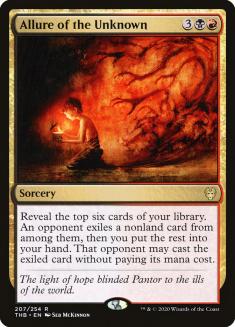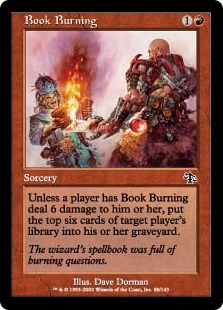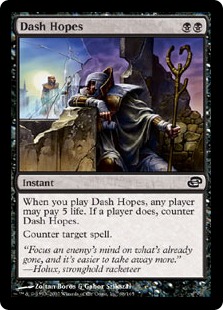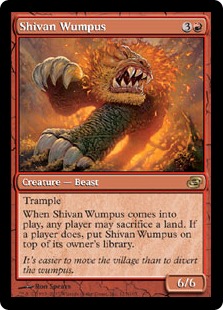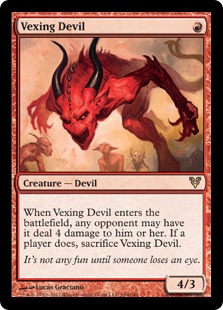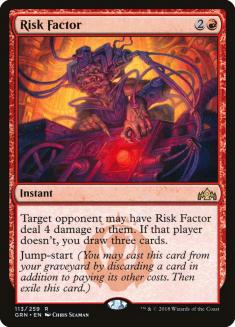My love for preview season is well-documented at this point. Others find joy in identifying the next broken format staple or the card that takes their favorite archetype to the next level. Personally, I find myself excited by the new puzzle that I get to attempt to solve. Speculating on how the pieces will all fit is the greatest joy Magic has to offer. Given this stance, it probably won’t surprise you to learn about my favorite type of preview card: the self-contained puzzle.
This is the card that is asking you, on its face, to figure out how to unlock its benefits despite potential weaknesses or drawbacks. It’s a microcosm of the bigger ongoing metagame struggle, and it’s the type of card that most often leads to a rapid-fire explosion of new archetypes. In figuring how to overcome a hurdle, we often employ cards and strategies which otherwise would totally miss in Constructed Magic. Of course, for this deckbuilding effort to be worth it, the payoff must be substantial.
How does drawing five cards for five mana sound?
Let’s talk briefly about heuristics and maxims in Magic. These things are useful. They take what is otherwise an unfathomably deep and complicated game and begin to make it the slightest bit approachable. However, there is a point in player development somewhere around the PTQ-grinder stage where maxims and heuristics begin to cement in player’s minds, and their actual application begins to look a lot more like that of a rule.
This rigidity begins to encroach on mindsets again at the mastery stage. With the rise of Arena and the explosion of new streaming talent picking up the game, we’ve seen repeated examples of people without 20+ years of heuristics and established maxims building decks in new and interesting fashions. While it’s almost impossible to effectively pinpoint the source of any piece of technology these days, I certainly think Crokeyz was instrumental in the rapid adaptation of maindeck Noxious Grasp in pre-Oko ban Throne of Eldraine Standard. While much of the old guard was somewhat reticent to add “sideboard cards” to their maindeck, Crokeyz proved it to be a valid approach by just winning. A lot. In the same fashion, we saw some prominent community members forced to eat crow upon dismissing the idea of ever banning a mere “sideboard card” like Veil of Summer (sorry Ced).
One of the common reviews I’ve heard of Allure of the Unknown is “punisher cards are always bad.” Punisher cards, if you don’t know, are those which present your opponent with a choice that determines the cards impact. The textbook example of this style of card is probably Browbeat.
There are a few reasons this rule is ready for retirement. First, early punisher cards affected the game in narrowly prescribed ways. Cards or damage. Mill or damage. Counterspell or loss of life. Sacrifice a land or face a 6/6.
With a card like Allure of the Unknown, the decision granted to the opponent is much more limited. An opponent may be able to deny you the best option available (and turn it against you), but five other cards are headed your way no matter what. That is an incredible burst of raw card quantity which doesn’t really find a parallel in a singular effect.
Furthermore, recent years have shown that even pure punisher cards can reach a point of playability if you continue to improve the rate.
Five cards for five mana is way beyond an acceptable rate. Once we agree upon this fact, our goal is clear: find ways to mitigate the drawback of a free spell for our opponent and find decks which benefit from a massive influx of raw card advantage. I immediately see five mechanical paths that can potentially benefit from Allure of the Unknown.
1. Devotion
The textbook Theros mechanic loves Allure of the Unknown. In Devotion decks, spell quality often scales directly with your buy-in to the overarching premise. While the best devotion cards will stand on their own merits, a Gray Merchant of Asphodel that drains for two does not equal a Gray Merchant of Asphodel that drains for ten. An important feature of Theros-era Mono-Black decks was their card advantage engine in the form of Underworld Connections. While Bolas’s Citadel is appealing, a six-mana artifact in a world that is ready to account for the card type with Thrashing Brontodon might leave us wanting. Let’s look at a build more focused on Allure of the Unknown.
Creatures (26)
- 4 Gray Merchant of Asphodel
- 4 Yarok's Fenlurker
- 4 Knight of the Ebon Legion
- 4 Murderous Rider
- 3 Ayara, First of Locthwain
- 3 Cauldron Familiar
- 4 Deathless Knight
Lands (25)
Spells (9)

I pushed hard on devotion synergies in this build and am placing a sizable bet on Deathless Knight being a powerful card when it is appropriately built around. One of the beautiful things about this deck is how much worse every spell becomes when you take away the surrounding context. A Deathless Knight that eventually finds its way back to your hand, Fenlurkers and Knights that might not be pumpable, pieces of a synergistic engine that just don’t do much on their own… only Murderous Rider and Drill Bit stand out as cards that should always be powerful when cast for free off Allure of the Unknown.
I passed on Erobos, Bleak-Hearted in this list because I don’t quite see the need for its style of payoff yet. It’s possible that I put the card on the battlefield for the first time and realize its combination of synergistic abilities is the end-game Rakdos Devotion is supposed to be building towards. In the context of maximizing Allure of the Unknown, it seems more important to prioritize black pips on the battlefield, so the five cards found can march us ever closer to a lethal Gray Merchant of Asphodel.
Devotion is just one of the synergies you can look to exploit when limiting the damage your cards can do against you. Consider spots where your whole deck is basically a singular ball of synergies.
2. Synergy
Creatures (21)
- 4 Midnight Reaper
- 4 Gutterbones
- 4 Priest of Forgotten Gods
- 4 Mayhem Devil
- 1 God-Eternal Bontu
- 4 Cauldron Familiar
Lands (25)
Spells (14)

These Rakdos Sacrifice decks have been extremely close to top-tier at various points in the post Throne of Eldraine metagame. If you spent any time playing games with them, their strengths were obvious. If the deck assembled a bunch of its pieces and did its thing, the power level was jaw-dropping. Where early engine setup was disrupted, the deck did nothing and had no relevant catch-up mechanisms.
By replacing the top-end with Allure of the Unknown, we gain a real card advantage engine that threatens to reassemble a gameplan out of nowhere, while offering an opponent surprisingly little. A Mayhem Devil on the opposing battlefield is sure to slow down the works, but how likely is it that the other five cards you’ve received are unable to answer the problem?
3. Low-Impact Cards
Here’s an idea: what if we just don’t play any good cards for our opponent to cast? Wait… come back…
Creatures (32)
- 4 Goblin Banneret
- 4 Gutterbones
- 4 Priest of Forgotten Gods
- 4 Footlight Fiend
- 4 Dreadhorde Butcher
- 4 Grim Initiate
- 4 Knight of the Ebon Legion
- 4 Stonecoil Serpent
Lands (20)
Spells (8)

Priest of Forgotten Gods is an unfortunate concession to our desire to cast a five-mana spell in our twenty-land deck, but otherwise these cards are all just miserable for your opponents to choose off Allure of the Unknown. Our early-game goes reasonably wide, and Heartfire gets to shine as a solid source of reach.
The clear problem with this deck is that we have mostly succeeded in building a far worse Experimental Frenzy aggro deck, but I did pick up on an important synergy along the way. Good luck casting that Stonecoil Serpent!
4. X-Spells
Creatures (8)
Lands (25)
Spells (27)

This deck is in the half-formed stage and probably needs to find a few more good X-spells before it really starts doing something truly powerful. Most options for your opponents will be suboptimal, and many Allure of the Unknown piles might represent stone misses.
You’re a control deck at heart, relying on massive bursts of card advantage to enable your removal-based gameplan. Recursive Chamber Sentries give some form of inevitability, assuming graveyards remain mostly unchecked in Theros Beyond Death. It’s possible you’re supposed to stretch into blue for some countermagic, which is another class of cards that can be happily exposed to Allure of the Unknown.
5. Teferi, Time Raveler
Teferi, Time Raveler blanks the downside of Allure of the Unknown in its entirety but has a dramatic mana commitment that I haven’t quite gotten over yet. My first attempts at decks containing Teferi were classic control shells, but in the absence of Teferi, Allure of the Unknown seemed too high-risk. You couldn’t bear an opponent finding their own Teferi and shutting off half your deck.
I was next drawn to a Fires of Invention shell, but the big drawback there was the large number of powerful cards your deck was sure to contain. I wasn’t thrilled at the prospect of my opponent casting their own Cavaliers and Kenriths at no cost. Then I again removed all the good cards from my deck, and things started to look promising.
Creatures (8)
Planeswalkers (4)
Lands (29)
Spells (19)

An important limitation of previous Fae of Wishes / Fires of Invention builds was that it was quite challenging to find appropriate card quantity to fuel multiple Fae of Wishes activations. Allure of the Unknown nips that problem in the bud. I don’t like where we stand in the Fires of Invention mirrors, so some dramatic format changes would have to occur before I’m heading down this path. After all, reactivity needs a purpose, whereas proactivity is its own reward. In the preseason, though, I’m fine spending some time fleshing out these ideas so I can have them in my pocket should the format break in an unexpected fashion.
Having to find unconventional setups like Bad Cards Fires is exactly why I love a card like Allure of the Unknown. I come to Magic for the creativity it inspires. I don’t want cards that are so powerful on their face that failure to play them is a clear mistake. I want to have to work for my payoff. If Theros Beyond Death keeps cranking out hits like Allure of the Unknown, Underworld Breach, and Ox of Agonas, I’m confident this set will grant my wish. Now we just have to figure out how to keep up with what Throne of Eldraine brought to the table…

